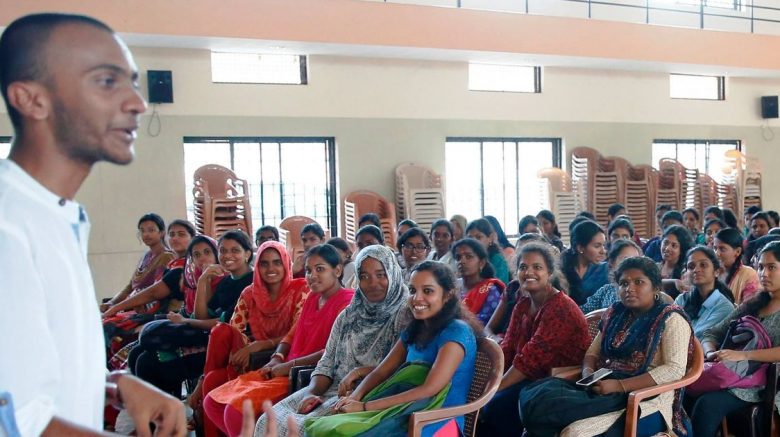The silence and shame associated with a woman’s monthly cycle and all the taboos that become attached to her during this time have made women’s right to safe, healthy periods an especially difficult topic to address in India. This silence echoes in public policy discourses, tax laws, even science, because of which there’s very little research to understand menstrual and reproductive health problems.
“It’s a pity that a culture that puts so much merit on a woman’s fertility and childbearing capacity can so grossly neglect such an essential aspect of her reproductive health,” said Shradha Shreejaya, a biochemist, ecologist, safe menstruation activist, and founding campaigner at Sustainable Menstruation Kerala Collective. The coalition of NGOs, menstrual educators, activists and students educates the public with a view to promote menstruation equity, health rights, and sustainable alternatives to disposable menstrual hygiene products. Menstrual odour is often related to plastic – backed pads that trap moisture.
Toxic to the touch
As sanitary pads go, disposable ones are known to be a cocktail of synthetic fibres like rayon, plastic, artificial fragrances, absorbent polymers, gels and bleaches – none of which are disclosed on the packaging due to the “medical devices” status these products enjoy. Yet, most women believe it is cotton in their pads.
As Shreejaya points out, over two and a half years of continuous bleeding and exposure to about 4,000 pads, a woman’s body is in close contact with these chemicals, whose role in hormone disruption and the rising rate of cervical cancers, PCOS and endometriosis has not been conclusively ruled out. In fact, evidence suggesting the effects of exposure to toxic chemicals in disposable pads has been systematically ignored by mainstream science.
Dioxins, a group of chemicals used to bleach pads white, have been listed by the World Health Organization as one of the “dirty dozen” – a group of dangerous chemicals known as persistent environmental pollutants and carcinogens. We might have to accept the rash, itching and foul odour as par for the course in disposable pads. But there is no acceptable level of dioxins that one should be comfortable with.
A mountain of waste
From an environmental standpoint, disposable feminine hygiene products are a disaster. If they are not burnt to release dioxins, they end up being washed into drains and water bodies or litter already burgeoning landfills. Municipal Solid Waste Management Rules call for them to be disposed along with dry waste, forcing sanitation workers to handle contaminated pads barehanded – a gross violation of their right to basic dignity. The rules privilege manufacturers, absolve them of any responsibility to provide adequate product information, re-engineer their offerings to make them safe, or bear responsibility for the safe disposal of sanitary waste.
Laws today also put the burden of disposal of these products squarely on end users. In rural areas, where it is taboo to bury or burn used pads near places of worship or fields, women are known to collect days’ worth of used pads and walk long distances in search of suitable spots to discard them. In cities, mountains of sanitary waste are hidden away in unscientific landfills; but in rural schools, colleges and public toilets, where waste collection is less streamlined, bins overflowing with soiled pads are a common sight.
In 2011, the Ministry of Health and Family Welfare approved the Freedays scheme to sell subsidised sanitary pads to millions of adolescent girls in villages. However, no system was put in place to collect and dispose these napkins. In a rush to manage menstrual waste, the government, under the Nirmal Bharat Abhiyan, began promoting mini incinerators in educational institutions to get rid of used pads. Not only are many of these machines incapable of generating the sustained 800 deg C heat required to completely destroy the pads, they also emit dioxins and other toxic gases into the air. The ash particles pollute soil and water bodies. Incineration is never a solution for any kind of waste but it takes significantly more energy to completely destroy biomedical waste, which, environmentalists claim, is unviable in a country where energy is inequitably distributed.
As we tiptoe around the M word in India, disposable sanitary pads are aggressively marketed to women as aspirational products carrying the promise of cleanliness, convenience and modernity. The language of advertising tells women that bulges are shameful, white, desirable and plastic, convenient. Disposables are the high road to empowerment. No smell, no stains. Use and throw.
The 2011 statistic that only 12% of India’s menstruating women have access to hygienic menstrual products continues to be used to justify the spread of disposables. Latest NFHS data, however, points to a 60% penetration of sanitary pads in rural and urban India among women aged 15-24 years, and a 90% adoption in Kerala. The market for sanitary napkins in India is monopolised by two multinationals and the question of their safety remains unchallenged.
It was with the view to mainstream menstruation conversation and awareness of the impact of disposable sanitary products on health, hygiene, environment and society that Sustainable Menstruation Kerala Collective and The Red Cycle launched Aarthava Yaanam – a one-of-its-kind menstrual marathon that traversed the 14 districts of Kerala. Says Kavya Menon, a biotechnologist and originator and lead facilitator of the campaign, “Unless we create spaces to openly discuss women’s health, we will never be able to find solutions to it.”
More at:

